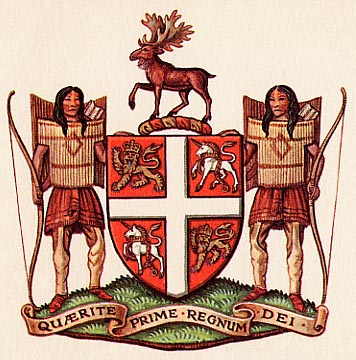
History

 |
Newfoundland History |
 |
Hands Across the Gulf
[This document was written in 1947. For the full citation, see the end of the text.]
Over the main entrance of Ottawa 's Parliament Building are ten shields. On nine of them are provincial coats of arms. The tenth is an uncarved block, left vacant in the event neighboring Newfoundland should ever join Canada as a tenth province. Last week, Ottawa wondered if it was time to carve.
The Bait. A seven-man delegation from Newfoundland was in Ottawa to discuss confederation. The delegation had been welcomed all along its route. In North Sydney , N.S., Mayor Alexander Thompson and his eight councilors tumbled out of bed at dawn, hustled down to the wharf at 5 a.m. to meet the delegates. In Montreal, Mayor Camillien Houde fussed over the visitors, let them sign the gilt-covered guest book with the pen the King and Queen had used. In Ottawa, External Affairs Minister Louis St. Laurent and other bigwigs greeted them at the station, whisked them off to a round of wining & dining. Prime Minister Mackenzie King gave a formal dinner at the Country Club.
The Plan. Next day, the delegates sat down with Mr. King, six Cabinet ministers, and top civil servants, for a full-dress show. As cameras ground and flashbulbs popped, Mr. King assured the delegates that any talk of confederation would be "received with understanding and good will." Responded salty Delegation Chairman Gordon Bradley: "Long may your big jib draw." In the afternoon, Minister St. Laurent handed the delegates a 5-page special brief outlining the Dominion-provincial setup. In return, he got a bulkier brief from the Newfoundlanders which pointed out among other things that the island's national debt stood at $217 a head (compared to Canada 's $1,062) and that Newfoundland had $29 million in a war-surplus kitty.
Then the delegates took a week off. Ottawa meantime would see if it could meet Newfoundland 's requirement of a $14 million-a-year subsidy (against $10,870,000 for Nova Scotia, with twice Newfoundland 's population).
The Catch. If Prime Minister King wanted Newfoundland's and Labrador's 155,000 square miles, he had his work cut out for him. He would have to calm the islanders' fears that they would be a still smaller voice in Government than the disgruntled Maritimers, that Canada 's heavier income taxes were preferable to Newfoundland 's heavier customs duties.
His offer would have to seem good enough to silence the highly vocal Water Street businessmen in St. John's , who see the ruination of their enterprises in the dropping of Newfoundland's tariff walls. The ticklish question of U.S. bases held in Newfoundland under 99-year-lease also needed an answer.
The Hope. It looked like spitting against the wind. While a Gallup poll last week showed that one out of two Canadians favored inviting Newfoundland, a poll by the Newfoundland weekly Herald showed that, out of 1,527 ballots received, 1,073 Newfoundlanders favored union with the U.S. and only 171 voted for confederation with Canada.
Last week, Newfoundland was busy celebrating the 450th anniversary of John Cabot's first landing It dedicated a new 200-mile road from St. John's to Cape Bonavista, called it Cabot Highway. That was enough to do, without thinking too much about confederation. Britain 's oldest colony was prepared to wait and see what the delegates brought from Ottawa .
Source : "Hands Across the Gulf", Time (Canadian Edition), July 7, 1947, p. 13.
Return to Canadian Views of Newfoundland's Entrance into Confederation
© 2004 Claude Bélanger, Marianopolis College |